Ask Alto : What are agile leadership principles and how can they help businesses cope with rapid change in 2024?

A month into 2024, there’s no doubt that it is going to be a challenging year.
On the geopolitical front, 2024 will be a record-breaking year for elections. The World Economic Forum says more than two billion voters in 50 countries will head to the polls. Key elections in countries like the United States, India and South Africa, and for the European Parliament, take place against a background of internal social divides and a global backdrop of two brutal wars and stubborn inflation.
The WEF’s Global Risk Report lists climate change as among the top five global longer-term risks, while in the immediate short term, misinformation and disinformation (for the first time) top the list of risks for 2024.
All these global challenges come home to roost in the C-Suite. Risk management around misinformation, economic decline, supply-chain disruption and inflation mean that adaptive capacity and innovation skills will be key - both in management practices and in an organisation’s choice of candidates.
Getting a handle on chaos
In times of turmoil, it can help to have a way to understand the trends one is seeing. One such paradigm is the BANI framework put forward by futurist Jamais Cascio. Writing in 2020, he described the world we live in as strange, out of control, immense, and fragile. His BANI concept has four pillars:
Brittle – when something appears strong but is susceptible to sudden collapse. Response: Resilience
Anxious – a sense of helplessness. Response: Empathy and mindfulness
Non-linear – when the results of actions taken, or not taken, can end up being wildly out of balance. Response: Flexibility
Incomprehensible - events and decisions seem illogical or senseless, Response: Transparency and intuition
READ: Ask Alto: What is BANI and should people care?
Michael Docherty, Partner and Co-Founder at Kindred, an organisational change consultancy, says that in an era increasingly defined by BANI, organisations can take the risk of continuing with business as usual… or they can harness the power of adaptive and agile leadership to stay ahead.
Agile, adaptive – what road to take?
Author and consultant Kate Christiansen notes that the words agile or agility, adaptive, and adaptable are frequently used as though they mean the same thing. It’s important to understand the distinctions between them though:
-
Adaptive means that something is consistently able to change itself, to accommodate and maximise the benefits of change (like a chameleon)
-
Adaptable means something that can be easily adapted (generally by someone, or something) to accommodate a change (like a dining table that can be extended to seat more people).
-
Agility is often used to describe a core quality an organisation needs if it is to succeed in a changing environment.
Adaptive leadership aims to understand the complexities of the environment, recognise that change is needed, and to be willing to challenge the status quo. Agile leadership focuses on leading teams in a way that promotes quick adaptation to change, iterative work processes, and flexibility in decision-making.
Narrowing it down: what is agile leadership?
Since transitioning an entire organisation to an adaptive vision is a huge task, it could make sense to start by introducing the concept of agility. The term “agile” as applied to a way of working originated in 2001 with a new approach to software development, according to a McKinsey report. In software development, the agile methodology promotes iterative development throughout the life-cycle of the project, close collaboration between the development team and business team, constant communication, and tightly-knit teams.
McKinsey notes that as organisations sought to become faster and more flexible, they recognised that the principles of agile software development could be applied much more broadly to management teams and to organisations as a whole.
Agile leadership emphasises:
-
An organisation-wide understanding of how stakeholders will derive value (and that includes customers, employees, investors, partners, and communities).
-
Having a strong backbone structure but replacing much of the traditional hierarchy with a flexible, small and scalable network of teams.
-
Working in rapid cycles of thinking and doing, breaking work down into small packages. These are executed in short, focused bursts and frequently reviewed based on carefully tracked goals and metrics.
New Year’s resolutions for CEOs
As always, the devil is in the detail. How does a traditional organisation move towards agile ways of working? For leadership teams, it might help to start thinking about these steps:
Update your own skills: Stay up to date with trends in your industry, and work on your own knowledge-base and professional development. This is key to maintaining a solution-focused, “How can I…” mentality.
Empower people to work with complexity: The age of chaos means we have moved beyond simply looking to optimise efficiency. People need to be empowered to make mistakes and learn from them. Iterative decision making, continuous feedback and transparency can create a shared sense of ownership and empowerment.
Break down the silos: Agile leadership emphasises on cross-functional collaboration by delegating authority and encouraging decision-making at all levels. By breaking down silos, agile leadership fosters a diverse range of perspectives on problems and change. Training and development initiatives aimed at broadening the skills of employees can enhance the effectiveness of cross-functional teams.